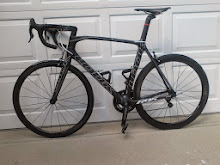Expensive remedies such as PV and wind are great, but it is much easier to conserve energy than to produce it. For some reasons we Americans tend to seek solutions that are expensive and sexy but require no individual effort or commitment. Oh, and by the way, we have no money so let's do nothing. Some people will think these suggestions are too hard. But hard is curing cancer. Hard is stopping domestic violence. Using a broom instead of a leaf-blower? Requiring campus vendors to provide healthy food? Trivial rewards for people who walk or ride their bikes instead of driving? It's slightly embarrassing that we even have to discuss these things. Embarrassing or not, here goes:
- Make recreaction center shower facilities freely available to anyone who commutes on foot or bike. Every little bit will help encourage those considering more healthy commuting alternatives.
- Intramural lawns are fine, but haven't we heard of xeric landscaping? Ditch the water-hogging bluegrass around buildings. Bluegrass in a semi-arid climate? Plus this reduces the need for smoggy lawnmowers (see below).
- Ban leaf-blowers. They do nothing but pollute. Brooms actually work, don't pollute and are quiet. Hey, if it's good enough for Paris (and Rome, Madrid, etc) it should be good enough for us.
- No parking on campus if you live within, say, 1.6 km, of the campus (with obvious health/disability exceptions). No more streams of healthy people from on-campus housing driving the entire 500m downhill to park on campus or, worse, work out at the gym.
- Back off the air conditioning. I'm tired of freezing my burgers off just so, it would seem, folks can wear suits and ties. It's slightly insane that in 2009 I have to hope it's hot enough outside that opening my (surreptitiously unbolted) windows will actually provide a little warmth. Otherwise I hug my computer to prevent hypothermia in July/August. We could simply regard suits/ties in the summer as environmentally inappropriate attire.
- Increase the albedo of the roofs. E.g., paint them white. no-brainer. Remind me to tell you my idea for albino buffalo some time.
- Provide covered bike parking, bike lanes and other similar amenities that people at CU, for example, take for granted.
- Close off central campus to cars. This helps get people in the habit of walking and allows for CO2 reducing xeric plants and trees.
- Replace gas powerd lawnmowers by rechargeable electrics. 2-stroke engines contribute as much pollution as all cars combined. Of course, once we get with xeric landscaping their won't be much if any grass to mow.
- Design buildings for passive lighting, heating and cooling. It's not rocket science. This is the problem with separating the construction costs from the maintenance costs of new buildings. Build for the future.
- Promote healthy, local, carbon-reducing food on campus.
- "The livestock sector emerges as one of the top two or three most significant contributors to the most serious environmental problems, at every scale from local to global." ref at HuffPo
- "refusing meat" is the "single most effective thing you can do to reduce your carbon footprint." ref at goveg.com
- the web site Veganfacts estimates that If all Americans became vegan it would free enough grain to feed 600,000,000 people.
- Encourage people to install instantaneous gas mileage meters in their cars (about $100). This is like bio-feedback for conservation. Average MPG doesn't help change your driving habbits. Once it's a game, men will compete.
- Make the cost of parking proportional to the weight of your vehicle and give discounts or prime spaces to HOV. I heard it costs around $35,000 to build one covered parking space on campus. As someone who works in an asbestos filled 1950s science building and has to dumpster dive to find desks for students, this makes a whole lot of sense.






